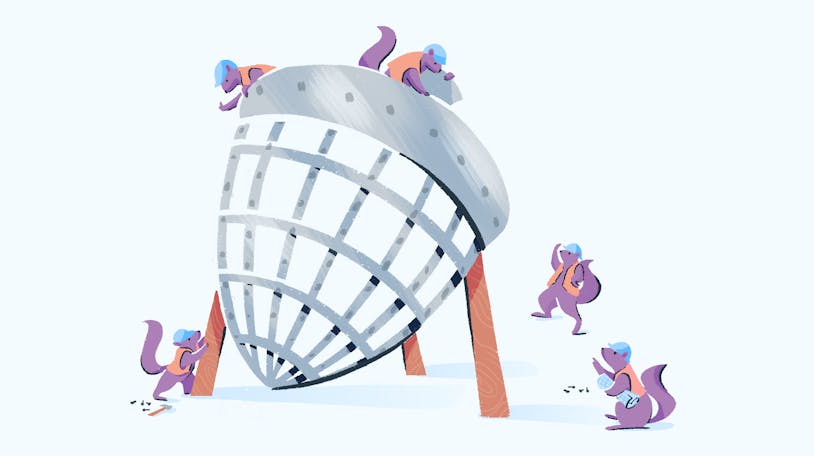Support Teams Should Have a Seat at the ‘Adult' Table


Mireille Pilloud knows what it takes to get support a “seat at the table” — in her role as Community Support Manager at TED, she’s made sure her team contributes to the growth and direction of the organization.
After her May 2016 talk at SupConf, we chatted with her about how that happened and what’s come out of it since.
You use the metaphor of the “kid table” and the “adult table” — can you tell us more about what you mean by that?
In our work, there are kid tables and there are adult tables. You sit at the kid table if you don’t feel like your work has an impact, if no one takes what you do seriously, and if no one understands exactly what it is you do.
The adult table is about reach and impact — making sure your team’s work is an integral part of your organization's ecosystem. How can you be a customer advocate if you’re only seen as an email monkey, someone to keep the customers at bay? The adult table is where your opinions matter, where decisions are made. And support needs to be at that table.
Try the customer support platform your team and customers will love
Teams using Help Scout are set up in minutes, twice as productive, and save up to 80% in annual support costs. Start a free trial to see what it can do for you.
Try for free
Do you think organizations set a place for support at the kid table by default?
Maybe not intentionally, but it’s common for companies to view support as a cost center, a team that provides little value to the organization as a whole. Support is an afterthought to the customer experience and therefore the support team doesn’t need to be a part of decision-making, so they end up at the kid table.
But I think we’re seeing a shift in how companies use support, where it’s a bigger part of the customer experience and ecosystem; it’s part of the feedback loop between the builders, sellers, and customers. There are still companies that ascribe to the old beliefs about the value of support teams. It gets outsourced to other countries or it’s siloed off in the basement. But I think that conversation is changing.
How did you change that conversation at TED and earn your spot at the adult table?
It was a lot of trial and error, and it took me a couple years to figure out. One thing that worked for me was making friends with the “adults” — the decision-makers in my organization — ensuring they knew who I was and what I do, and learning what was important to them.
Making friends with the “adults” at work isn’t about finding someone to go to happy hour with; it’s about finding an ally with whom you can share resources for mutual benefit. They can help legitimize what you do to other teams so that they can also benefit from the work you do.
It’s sort of like having a cool aunt who understands you. I’ve got a whole team of “cool aunts” in our tech team.
How did you make friends with the “cool aunts” on your tech team?
In 2014, we were about to release a new version of our site, but the support team already had 2,700 unanswered conversations, 900 of which hadn’t received a response for over a month. On top of that, we had no reporting system. We didn’t have the resources we needed for what was coming, but the customers were coming whether we were ready or not.
The tech team wanted user feedback through each phase of the launch, the product team wanted to know if there were any usability issues that could be resolved, and engineering wanted to hear about bugs they could fix before the public launch.
Because they all had a stake in the new site’s success, recognized the value of feedback, and knew we needed help, we were able to collaborate and prepare for the site launch by creating an FAQ, writing internal training documents so agents would know what to expect, and building a reporting system so the tech team could get the feedback they wanted.
And it worked! We crushed the site launch. Our collaboration provided the tech team with the feedback they were looking for, and support was able to guide users through the site launch.
So that’s the “mutual benefit” part — the tech team helped you create documentation and reporting systems because they needed something too?
Right — you have to figure out which problems you share and approach them with the idea that you both have something to gain by working together. But first you have to make sure those people know who you are and what you do.
The people launching initiatives are at the adult table making plans and decisions. They’re not intentionally leaving you out; they just don’t think to include you. If you want to be included among the adults, you have to get in front of them. They’re probably not going to think to loop you in otherwise.
And how do you get in front of the decision-makers?
Write regular updates and present whenever you can. When one of my cool aunts suggested I present at a big meeting, I initially said “no thanks!” Presenting is terrifying, but it gave me the opportunity to share the gospel of support. So I mustered my courage to get up in front of dozens of colleagues, and I didn’t die. On top of not dying, I planted a little seed in everyone’s brain, that customer support is a team, customers are real people with problems, and my team helps solve those problems.
Reporting regularly through writing and presenting keeps your team relevant and in the forefront of people’s minds.
What kinds of things should you be writing and presenting about?
When you’re writing or presenting, it’s important to show two sides of the information you’re sharing: the data and the story.
Data: Share what’s going on with customers — how many bugs there are, interesting feature requests, common questions. Share how your team is doing — we handled this many conversations, this is how fast we’re responding. Paint a picture of who your customers are and how you help them.
Sharing data gives you credibility. “We handled 700 conversations today.” “More than 100 people had trouble creating accounts.” “There are six bugs in the current version.” Using numbers shows you did your homework. You’re not just sharing feelings about your work; you’re sharing facts, and facts are harder to argue with. People are more likely to listen to and value what you’re saying when you back it up with data.
Stories: Where numbers build credibility, stories build empathy. Stories make your work accessible and bring issues to life.
For example, a customer wrote in complaining that our site didn’t recognize their email sign-in, yet they got regular emails from us. The issue was that they’d signed up for our newsletter, but not an account. Sharing this story, using screenshots and walking the tech team through the customer’s process, made the user experience tangible. We were able to change the language in the UX and add an account sign-up option so future customers wouldn’t run into the same trouble.
When you do your own PR, your team remains relevant. Once people know what you do and what your value is, you’ll be looped into more and more decisions.
How do you figure out what’s important to the “adults”?
This is the real meat of building credibility. If you want people to listen to you, you have to prove you’re good at listening. You need to show that you care about and understand others’ work. What do others need help with that overlaps with your work?
You can “lurk” during casual kitchen conversations and listen to others at all-hands meetings to understand the issues others are facing. Then you can go to another team and say, “I see you’re having a problem with this; here’s how we can help,” which shows you’re listening and you have ideas for solutions.
Seeing what’s important to others and delivering the right information can be a challenge. It helps to let go of your own desires. From a customer’s perspective, there may be something you think is important, but for whatever reason the tech team won’t work on it. Maybe they have bigger fish to fry.
It’s easy to get emotional and feel for the customer. Empathy is how a lot of us got where we are now. But the customer’s view doesn’t always match the organization's goals. In order to work with the adults, you need to show you can make the distinction. Sometimes being a customer advocate means being honest about what is and isn’t possible.
When you’re at the adult table, people know what you do and how important it is. They take the things you say seriously because you’re a trusted source of information. Your team’s work has a bigger impact. It’s not for your ego; it’s about doing your job more effectively.
How has your perspective changed now that you’re at the adult table?
Now I actually see the fruits of my labor. We just formed a new mobile team, and they’re coming to support for feedback and working on ways to integrate a feedback loop into the app that didn’t exist before. And that’s because they know my team exists and they can lean on us to process and analyze the feedback that’s coming in, and help users feel heard.
When you feel like you’re taken seriously, you get to see the fruits of your labor, as opposed to just throwing stuff into a black box and hoping someone cares.
The Supportive Weekly: A newsletter for people who want to deliver exceptional customer service.
